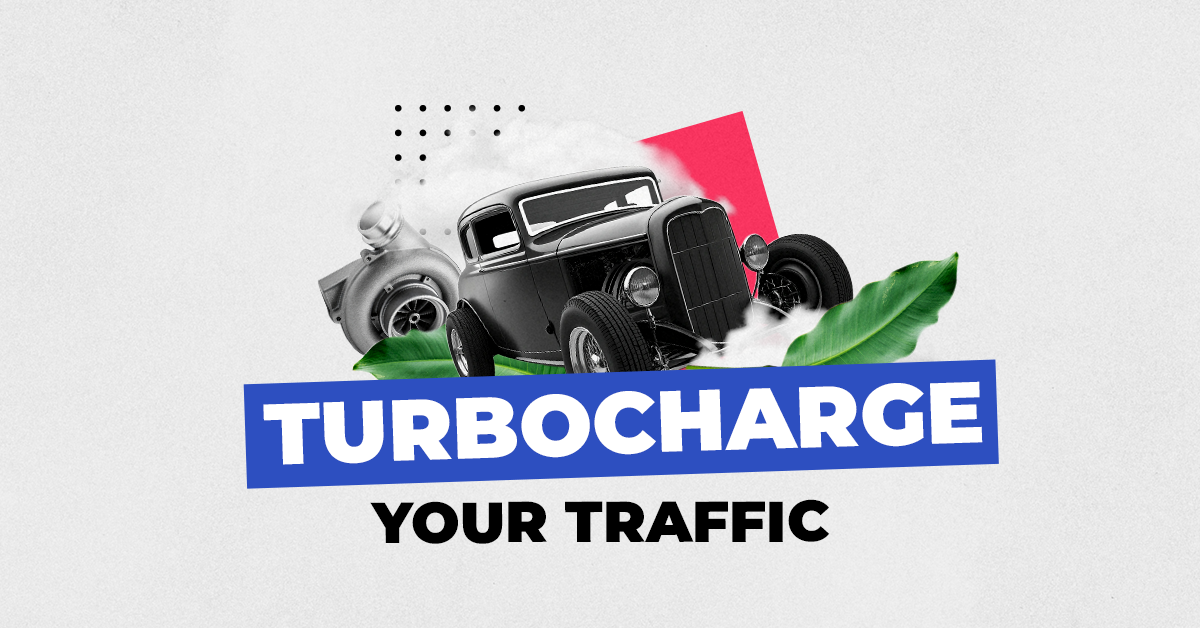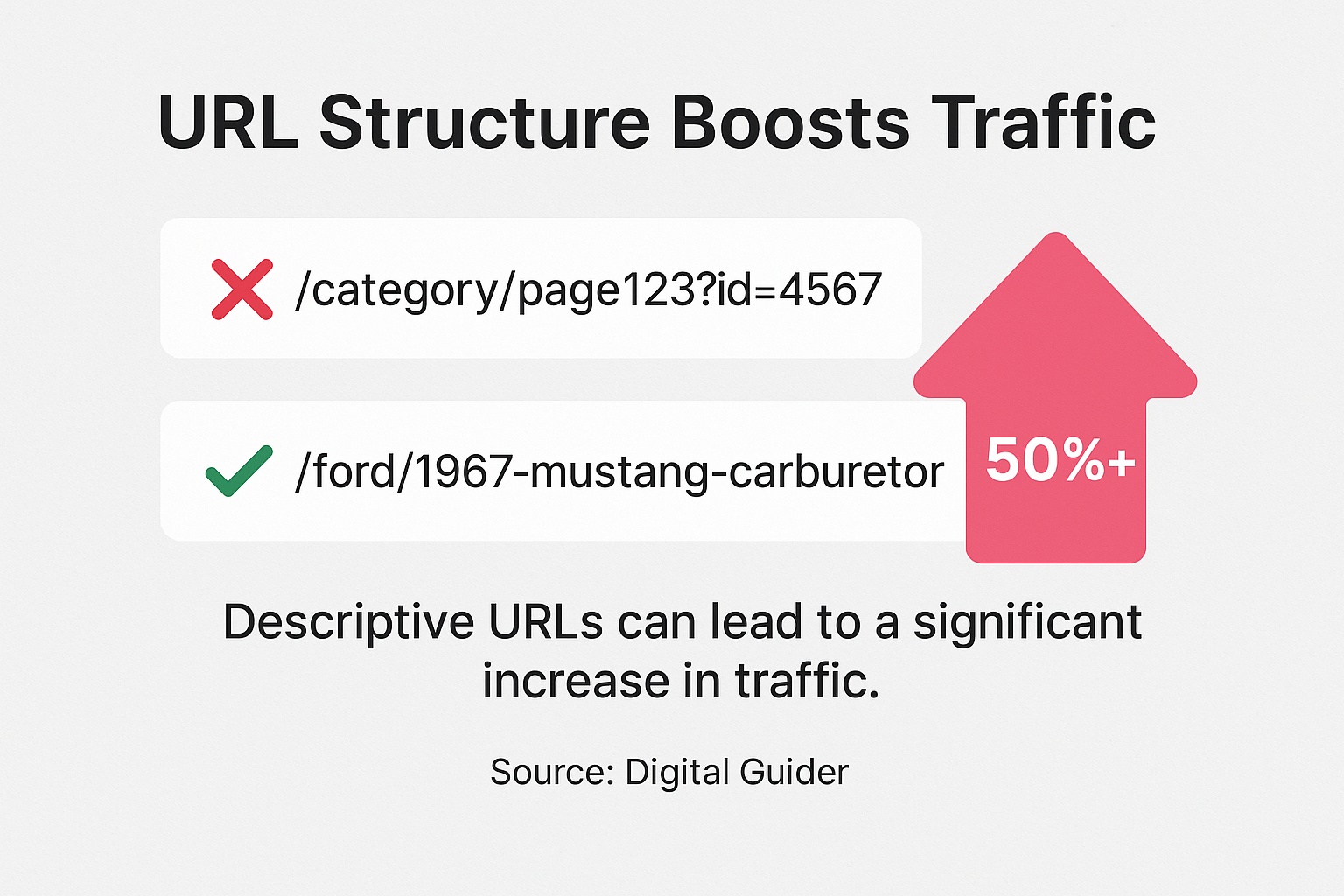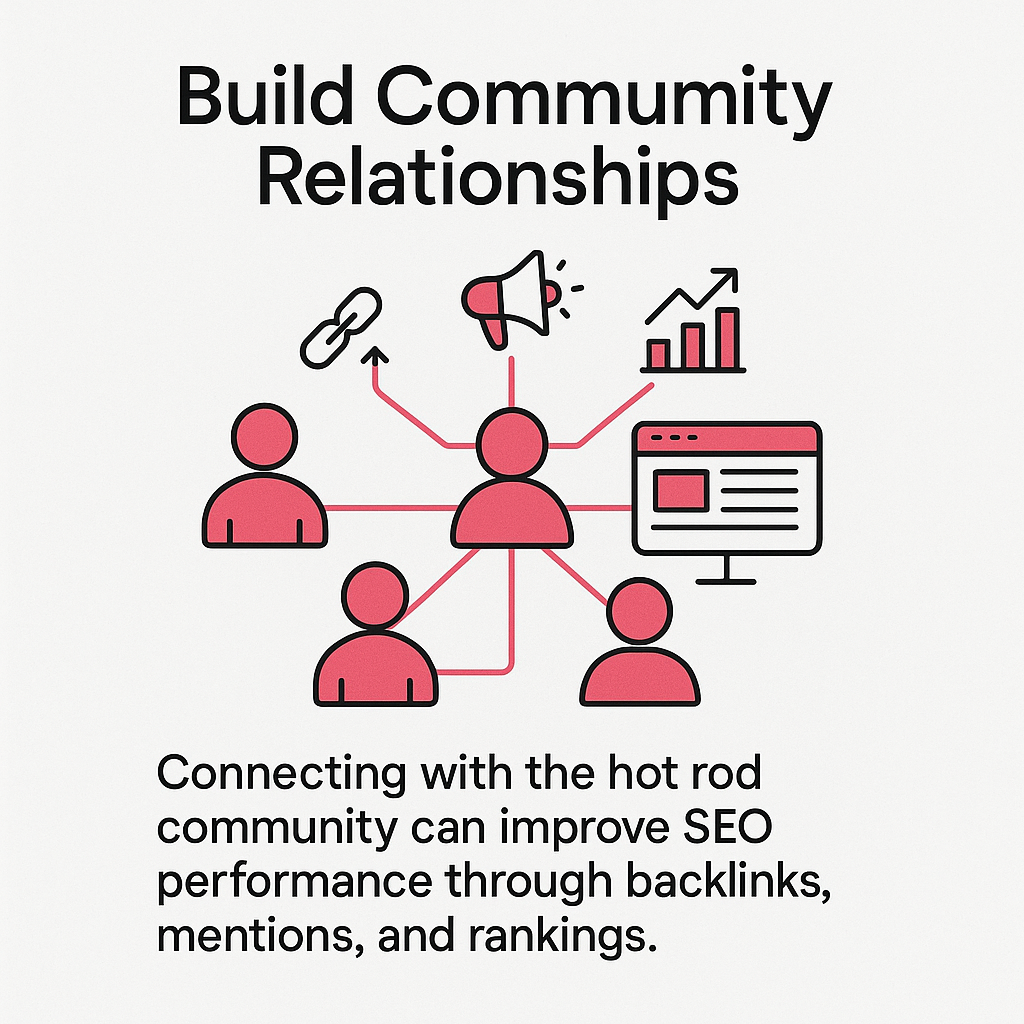
You know that feeling when someone walks into your shop looking for a specific carburetor for their '67 Camaro build, and you've got exactly what they need sitting on your shelf? That's the magic we're trying to recreate online – except instead of them wandering in by chance, we want hot rod enthusiasts finding your parts through search engines when they're hunting for exactly what you sell.
I've been helping automotive parts suppliers turbocharge their online visibility for years, and I can tell you that the restoration parts market has some unique quirks that make SEO both challenging and incredibly rewarding. Hot rod builders don't search like regular car owners – they use part numbers, vintage terminology, and specific fitment details that would make a modern car owner's head spin. But here's the thing: when you master SEO for this niche, you're not just competing with every generic auto parts store. You're connecting with passionate builders who know exactly what they want and are willing to pay for quality.
In this guide, I'll walk you through the specific SEO tactics that actually work for hot rod restoration parts suppliers. We'll cover everything from understanding how enthusiasts search for parts to technical optimization tricks that'll make your product pages rank higher than your competition. Plus, I'll share some real data on what kind of results you can expect when you get this right.
Before we get into the nitty-gritty of SEO tactics, we need to understand how your customers actually search for parts. It's not like someone looking for brake pads for their daily driver – hot rod builders have a completely different search behavior that most SEO guides completely miss.
Hot rod shoppers use six main search patterns that you need to optimize for (Source: Hedges & Company). First, there's part search with vehicle fitment – think "small block Chevy intake manifold 1969." Then you've got part number searches, including OEM crossovers where builders are looking for modern equivalents of vintage parts. The third pattern is informational searches like "how to rebuild a Rochester Quadrajet carburetor," which is where content marketing becomes pure gold.
|
Search Pattern
|
Example Query
|
SEO Opportunity
|
|---|---|---|
|
Part + Fitment Search
|
"small block Chevy headers 1955-1957"
|
Product pages with detailed fitment data
|
|
Part Number Search
|
"Holley 4160 600 CFM carburetor"
|
Include manufacturer part numbers in titles
|
|
Informational Search
|
"how to choose carburetor size for 350 engine"
|
Educational blog content
|
|
Symptom Search
|
"engine hesitation on acceleration hot rod"
|
Troubleshooting guides linking to products
|
|
Brand Search
|
"Edelbrock Performer intake manifold"
|
Brand-specific category pages
|
|
Category Search
|
"classic Mustang suspension parts"
|
Well-organized category pages
|
The fourth search type is symptom-based, where someone searches "engine knocking in 1955 Chevy" – they know something's wrong but aren't sure what part they need. This is where you can really shine by creating troubleshooting content that guides them to the right solution. Brand searches and category searches round out the six patterns, and each one requires a different SEO approach.
Now that we understand how your customers search, it's time to build an SEO foundation that actually works for the restoration parts market. The key here is matching your website structure to how enthusiasts think about their projects, not how generic auto parts stores organize their inventory.
Start by organizing your site around popular restoration project categories. Instead of generic "engine parts," create sections like "Small Block Chevy Rebuild Kits," "Ford Flathead V8 Performance Parts," or "Classic Mustang Suspension Upgrades." This approach aligns with how people actually search and makes it easier for search engines to understand what you're selling.

Your URL structure should be clean and descriptive – something like /ford/1967-mustang-carburetor rather than /product/12345. This helps both users and search engines understand what's on each page (Source: Digital Guider). I've seen suppliers boost their organic traffic by over 50% just by switching from generic product URLs to descriptive ones that include the make, model, and part type.
Here's where most auto parts SEO advice falls flat – it treats hot rod parts like commodity items instead of specialized restoration components. Your keyword research needs to account for the passionate, knowledgeable audience you're serving.
Begin by creating topic clusters around popular restoration themes (Source: Hedges & Company). Think "vintage carburetors," "custom exhaust fabrication," or "restoration tips for 1960s muscle cars." Within each topic, you'll build out keyword lists that include both broad terms and specific long-tail phrases that serious builders actually use.
The magic happens when you combine these keywords with your deep knowledge of the restoration community. You know that someone searching for "Muncie 4-speed transmission parts" is probably working on a serious muscle car build and has money to spend on quality components. That's valuable intelligence that generic SEO tools can't give you.
Technical SEO for hot rod parts requires a different approach than what works for regular ecommerce sites. You're dealing with complex fitment data, vintage part numbers, and customers who need extremely specific information before they'll buy.
Schema markup becomes absolutely critical here. You need to implement product schema that includes all the fitment details, part numbers, and compatibility information that search engines can understand. When someone searches for "1969 Camaro Z28 exhaust manifolds," you want Google to know exactly which of your products match that specific application.
Speed optimization is crucial because restoration builders often browse catalogs for hours, comparing parts and specifications. A slow-loading site will kill your conversion rates faster than overpriced shipping. Focus on optimizing your product images – high-quality photos are essential for parts sales, but they need to load quickly on mobile devices too.
|
Technical Element
|
Hot Rod-Specific Implementation
|
SEO Impact
|
|---|---|---|
|
Schema Markup
|
Include fitment years, engine sizes, compatibility
|
Rich snippets in search results
|
|
URL Structure
|
/make/year/model/part-category/specific-part
|
Better keyword targeting and user experience
|
|
Image Optimization
|
Alt text with part numbers and fitment details
|
Image search visibility for visual shoppers
|
|
Site Speed
|
Compressed high-res product images
|
Lower bounce rates, better rankings
|
Don't forget about your accurate fitment data implementation – this is where ACES and PIES standards become your best friend. Clean, structured fitment data doesn't just help with SEO; it reduces customer service calls and returns because people can find exactly what fits their project.
Content marketing for performance parts, like hot rod parts, isn't about pushing products – it's about becoming a trusted resource for the restoration community. The builders who become your best customers are the ones who see you as experts, not just another parts vendor.
The most effective content focuses on project-based approaches rather than individual parts. Instead of writing "10 Best Carburetors for Small Block Chevy," create content like "Complete Guide to Choosing the Right Carburetor for Your 1969 Camaro SS Clone Build." Notice how the second approach speaks directly to someone working on a specific project with clear goals.
Video content performs exceptionally well in this space because restoration involves so much visual problem-solving. Before-and-after installation videos, parts comparison guides, and troubleshooting walkthroughs all attract natural backlinks from forum discussions and social media shares (Source: Digital Guider). I've seen performance parts brands successfully use content marketing to build authority that translates directly into higher search rankings.
Even if you ship nationally, local SEO can be incredibly valuable for hot rod parts suppliers. Many builders prefer working with shops they can visit, especially for complex builds or custom fabrication work.
Start by claiming and optimizing your Google Business Profile with accurate business information, photos of your shop and inventory, and regular updates about new arrivals or special projects. Consistent NAP (Name, Address, Phone Number) information across online directories helps Google understand your business location and specialization (Source: Digital Guider).
Customer reviews become especially important for local SEO in the hot rod space because the community is relatively small and word-of-mouth carries huge weight. A few detailed reviews from well-known builders can boost your reputation more than dozens of generic five-star ratings.
Here's the reality: you're never going to outrank the big box auto parts stores on generic terms like "brake pads" or "oil filters." But here's the good news – you don't need to. Your advantage lies in your specialized knowledge and the specific needs of the hot rod community.
Focus on niche expertise rather than trying to be everything to everyone (Source: Hedges & Company). When someone searches for "Hilborn fuel injection system for flathead Ford," they're not looking for AutoZone. They want a supplier who understands vintage fuel systems and can provide the technical support that comes with specialized knowledge.
Your content should demonstrate this expertise at every opportunity. Instead of generic product descriptions, write detailed explanations that help builders understand why this part is right for their specific application. Include installation tips, compatibility notes, and cross-references to related components that serious builders will appreciate.
|
Competition Strategy
|
How to Implement
|
Expected Outcome
|
|---|---|---|
|
Niche Specialization
|
Focus on specific eras, makes, or build types
|
Higher rankings for specialized terms
|
|
Expert Content
|
Technical guides, installation tips, compatibility info
|
Establishes authority and trust
|
|
Community Engagement
|
Participate in forums, sponsor events, support builds
|
Natural backlinks and brand mentions
|
|
Superior Product Data
|
Detailed specs, high-quality images, fitment charts
|
Better user experience and conversion rates
|
The technical SEO improvements specific to automotive ecommerce can give you a significant edge over larger competitors who treat auto parts like generic products. When your product pages load faster, provide more detailed information, and offer better search functionality, customers will choose you over the big retailers even if your prices aren't the lowest.
The metrics that matter for hot rod parts SEO are different from generic ecommerce KPIs. You're not trying to generate massive traffic volumes – you want qualified visitors who are serious about their builds and willing to invest in quality parts.

Focus on tracking organic traffic growth for your target keywords, but pay special attention to the quality of that traffic. A visitor who spends 10 minutes browsing your small block Chevy section and downloads your cam selection guide is worth more than 10 visitors who bounce after viewing one page. Automotive SEO campaigns can deliver impressive results – case studies show 136% growth in organic users, 129% more sessions, and 102% more top-10 keyword rankings when done correctly (Source: Embarque).
Conversion rate tracking becomes especially important because hot rod parts often have longer sales cycles than regular auto parts. Someone might research a complete suspension kit for months before making a purchase. Set up Google Analytics goals that capture this behavior – email signups, catalog downloads, and quote requests are all valuable conversions even if they don't immediately result in sales.
Set up conversion tracking that reflects the reality of how hot rod builders shop. Create goals for actions like downloading fitment guides, requesting custom quotes, or signing up for restock notifications on hard-to-find parts. These micro-conversions often predict future sales better than immediate purchase data.
Use Google Search Console to monitor which specific part numbers and fitment combinations are driving traffic to your site. This data helps you identify gap opportunities – parts that people are searching for but not finding on your site. I've helped clients discover profitable niche markets just by analyzing their search console data for unexpected queries.
|
Metric Category
|
Key Indicators
|
Success Benchmarks
|
|---|---|---|
|
Traffic Quality
|
Time on site, pages per session, return visitors
|
5+ minutes average, 3+ pages, 30%+ returning
|
|
Keyword Performance
|
Rankings for niche terms, featured snippets
|
Top 3 positions for target keywords
|
|
Content Engagement
|
Guide downloads, video views, social shares
|
20%+ engagement rate on educational content
|
|
Local Visibility
|
Google Business Profile views, local pack rankings
|
Top 3 in local pack for key terms
|
Your internal linking strategy should also be tracked and optimized based on user behavior. Hot rod builders often research multiple related parts during a single session, so your internal links should guide them through logical product combinations and upgrade paths.

Once you've mastered the basics, there are some advanced tactics that can really set your site apart from the competition. These strategies require more effort but can deliver significant results for suppliers willing to go the extra mile.
Consider creating detailed product descriptions that tell the story behind each part. Hot rod builders love knowing the history and development of components they're installing. A carburetor description that mentions its racing heritage or explains design improvements over earlier versions connects with enthusiasts on an emotional level while naturally incorporating relevant keywords.
Implement dynamic content that adapts based on search queries. If someone lands on your site after searching for "1969 Camaro SS parts," show them a customized homepage highlighting Camaro-specific products and related build guides. This level of personalization improves user experience and increases the likelihood of conversion.

The hot rod community is tight-knit, and building authentic relationships within this community can dramatically improve your SEO results. When respected builders and industry figures naturally mention your business or link to your content, those signals carry enormous weight with search engines.
Consider sponsoring local car shows, providing parts for featured builds, or partnering with popular YouTube channels or build blogs. The natural backlinks and brand mentions from these relationships are worth more than any paid link building campaign. Plus, you're strengthening your connection to the community you serve, which always leads to better business outcomes.
Your SEO strategy for aftermarket parts growth should always keep this community aspect in mind. Hot rod builders trust recommendations from other enthusiasts more than any marketing message, so focus on earning those genuine endorsements through excellent products and service.
The path to SEO success for hot rod restoration parts suppliers isn't about chasing the latest algorithm updates or copying what works for other industries. It's about understanding your unique audience, providing the detailed information they need, and building your reputation as a trusted expert in the restoration community. When you get these fundamentals right, the search rankings and sales growth will follow naturally.
Our customers value boutique agency approach with access to a seasoned team, profit-based goals, and clear communication.



